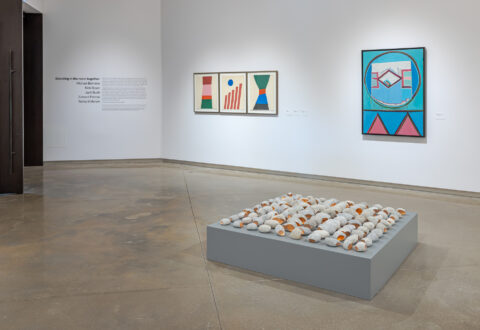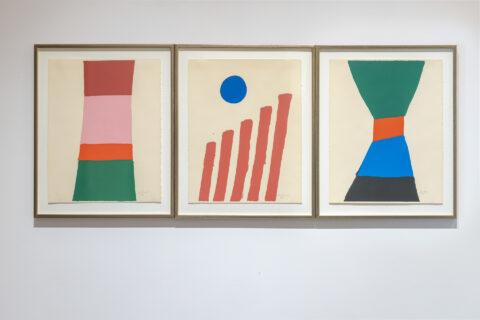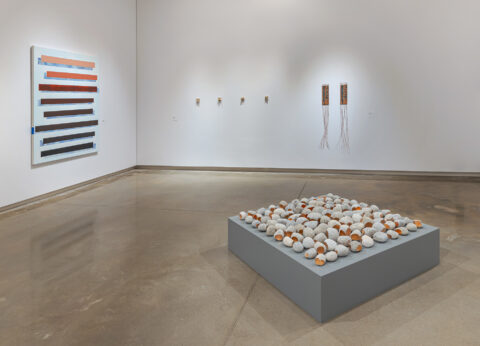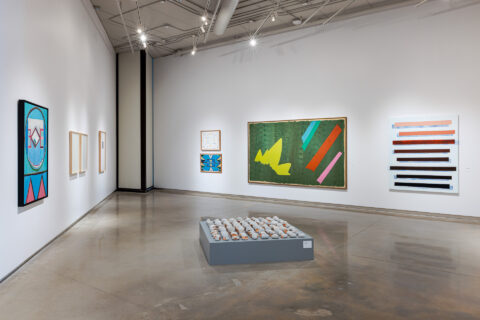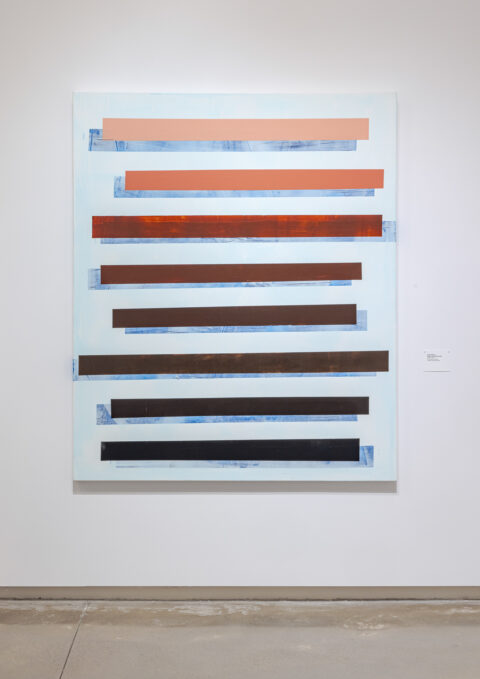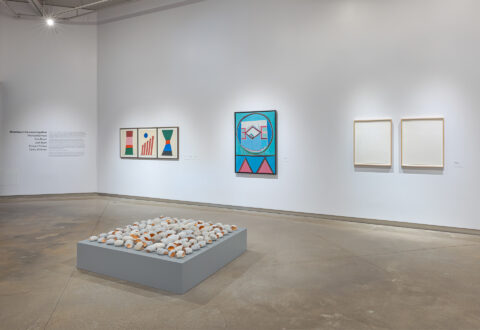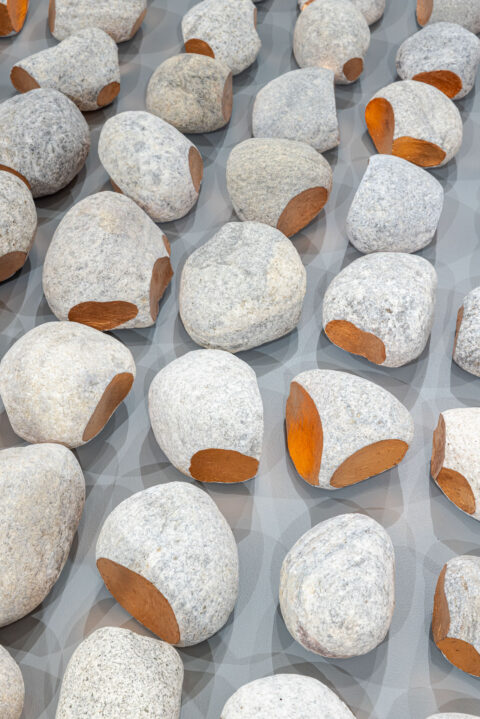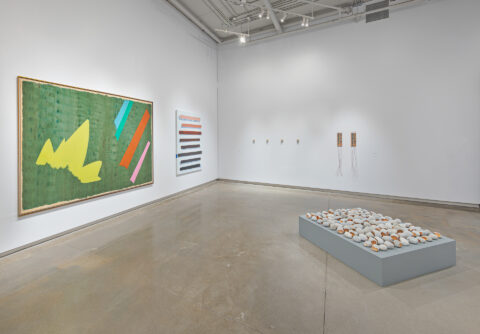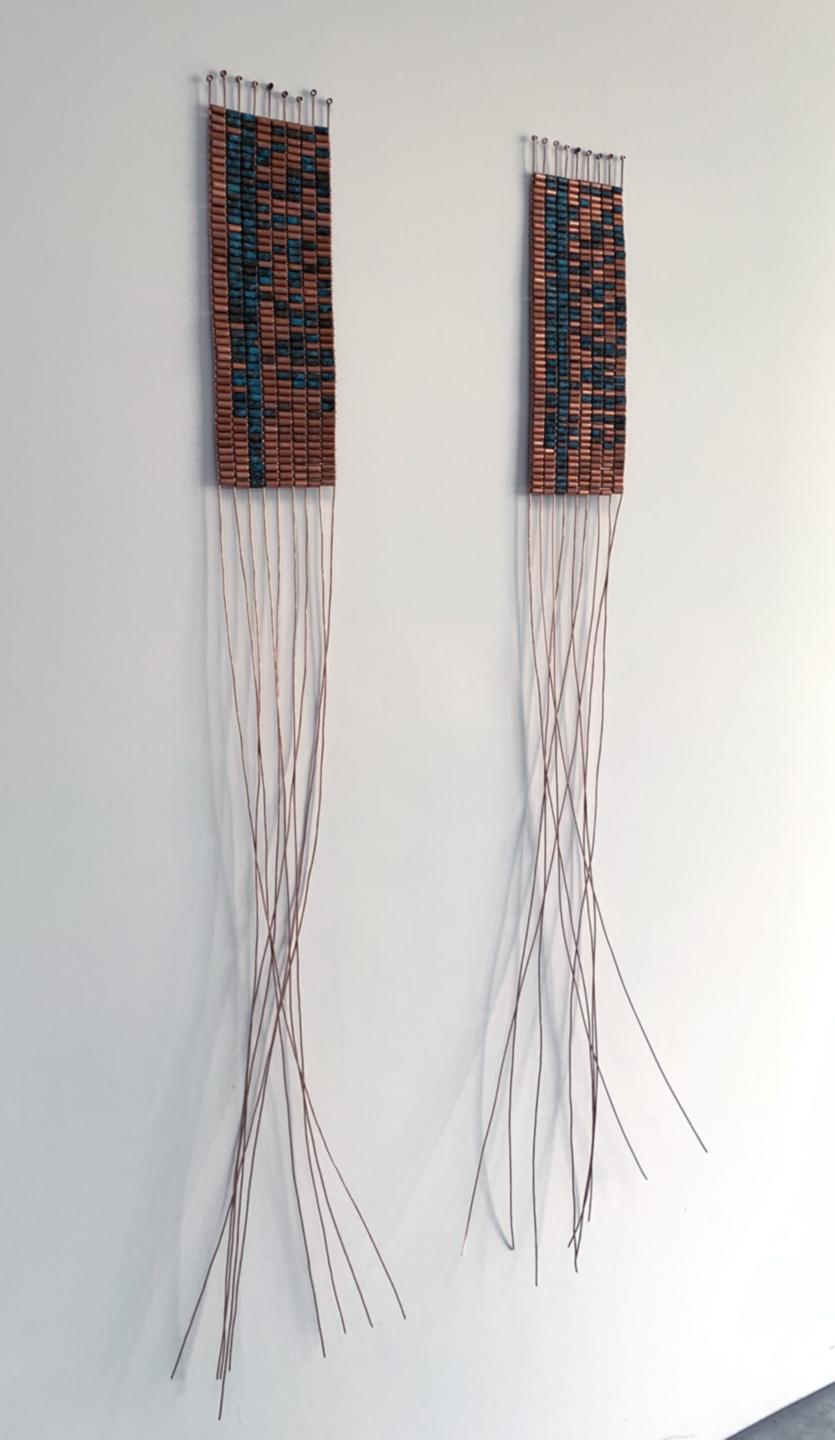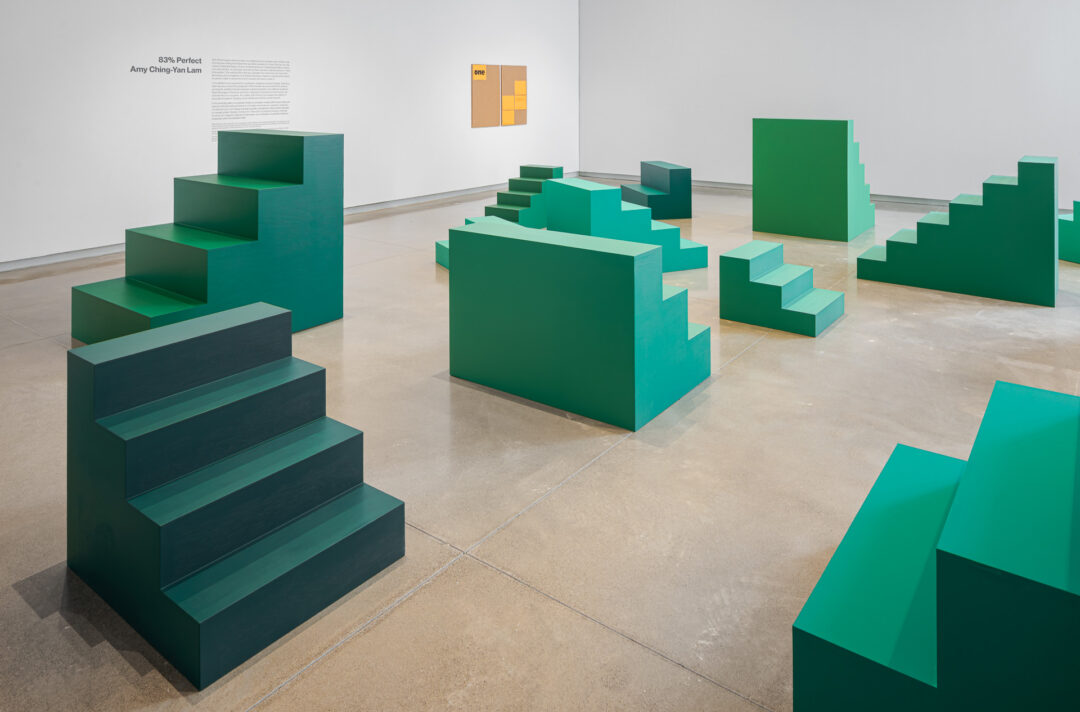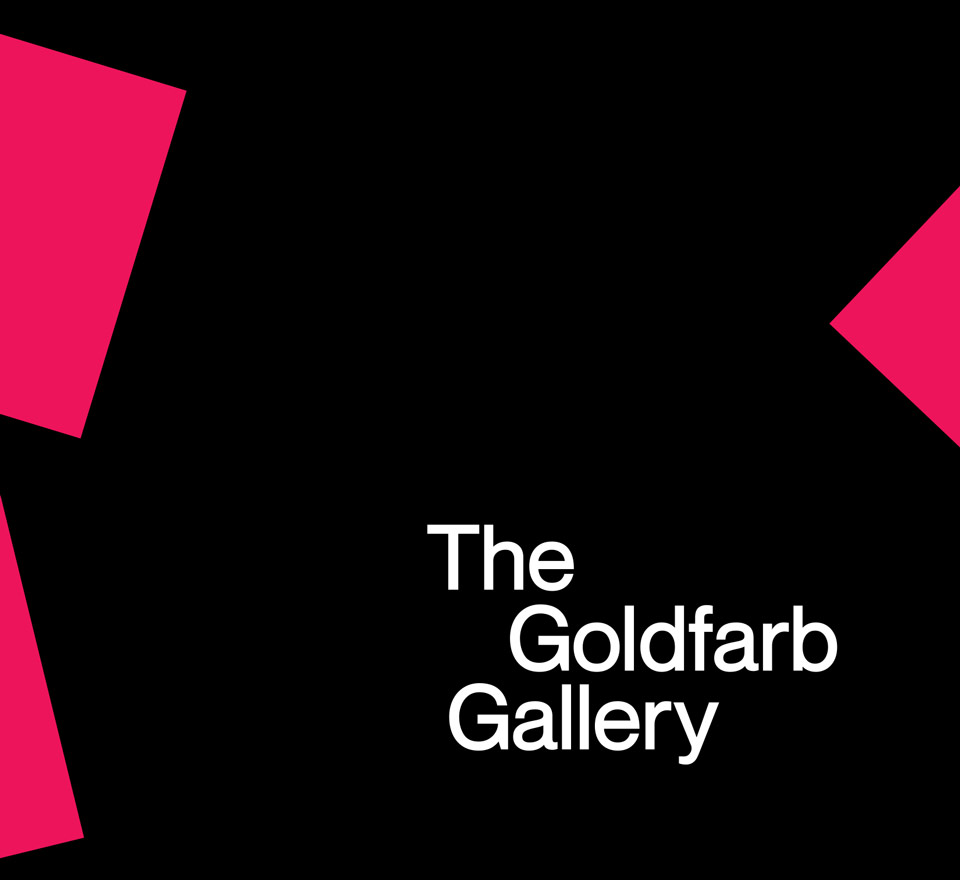Please note:
The gallery will be closed as of December 21, 2025, for the end of year break. We will resume regular hours on January 6, 2026.
September 26, 2025 – January 31, 2026
Standing in the room together
Triangle gallery
Featuring: Michael Belmore, Bob Boyer, Jack Bush, Edward Poitras, and Tariku Shiferaw
Standing in the room together is an exhibition grounded in relationships. Starting with artworks from the York University Art Collection, the exhibition travels a circuit of influences and inheritances, suggesting that while artworks are situated in their own time, they also continue to impact and influence artists and publics through continuing existence. The privilege of the University’s collection is the opportunity for artworks to live many lives, in association with unexpected companions related to future exhibitions but also because of where they may reside inside a vault.
During my tenure as Curator of Collections and Contemporary Art Engagement for The Goldfarb Gallery, Michael Belmore attended one of the first collection tours I led through the gallery’s new Visible Vault. The artist and I subsequently spoke about the throughline of modernist aesthetics in York University Art Collection. In our conversation, Belmore began to share connections and references sparked by seeing Jack Bush’s paintings and prints which reminded him of a particular element in Bob Boyer’s artwork, which led me to bring up a recently acquired painting by Tariku Shiferaw, which led us to the seed for this exhibition. I invited Belmore to engage with the permanent collection and to collaborate on an exhibition that showcases his work in relation to the collection and beyond to artists who have influenced his practice.
Abstract painter Bush has significant representation within the York University Art Collection, acquired some of his prints in the founding years of the Keele campus and augmented by a significant donation by Joan and Martin Goldfarb in the early 2000s. Bush, a member of Painters Eleven, had significant impact on bringing wider appreciation to abstraction within Canada. Featured in this exhibition is the major painting Flack, 1970–72, along with several works on paper demonstrative of Bush’s well-established abstract style featuring washes of colour and amorphous shapes.
Also in the exhibition is Bob Boyer’s He Dreams of Dancing Horses, 1982, a piece demonstrative of his symbolic vocabulary, frequently used within his abstract works. A recurring motif, the bilateral symmetrical “E” shapes representing a horse’s legs frequently appears in Boyer’s work. Many of Boyer’s elemental designs contain spiritual meaning of significance to Plains culture (the number seven, arrows, and storms), included to stress the importance of self-identity and cultural sovereignty within his own design philosophy. Boyer emphasized these principles frequently beyond the scope of his own paintings as a professor and department head at Saskatchewan Indian Federated College (now First Nations University of Canada), stating; “First Nation’s art cannot be taught independent of First Nations theory.” (1)
Famously, Boyer engaged directly with Bush’s abstract symbology, observable in the centre of He Dreams of Dancing Horses, where Boyer includes amorphous stripes reminiscent of Bush’s recognizable style. Boyer’s engagement with Bush’s style of abstraction can be understood as a reclamation of abstraction within a longer and larger scope. Boyer has commented on his relationship to abstraction, saying; “I consider myself an abstract painter using a very ancient Northern Plains tradition of abstraction that modern artists dipped into and copied. So, the history of this [Boyer’s work] is older than modern abstraction. Where I’m coming from is more deeply rooted.” (2) The works by Boyer in this exhibition are loaned courtesy of Michael Belmore as well as the collection of Barry Ace and Earl Truelove.
Boyer was also a curator and had a long conversation with the work of Edward Poitras. He curated Poitras on two occasions, in New Work by a New Generation, 1982, and again in A History Lesson: contemporary Aboriginal art from the collection of the MacKenzie Art Gallery, 2004. Boyer and Poitras were featured together in 1984 as part of the exhibition Horses Fly Too, organized by the MacKenzie Art Gallery and the Thunder Bay Art Gallery, and we bring them together again in this exhibition. As part of Standing in the room together, we present Poitras’ Small Matters from 1989, featuring crumpled pages from the book Bury My Heart At Wounded Knee: An Indian Story of the American West, placed within wire and nail enclosures. Below these enclosures, almost invisible in white vinyl on a white wall, are the names of four nineteenth century massacres as well as the names of the Indigenous peoples who were victims of these massacres. This work by Poitras reflects on historical events often left out of typical Eurocentric narrations of history and in general his work references ideological conflicts through juxtaposition. Political statements are disguised, hidden among traditional cultural references such as buffalo or horse skulls, which come to stand in for a past that was irrevocably altered by colonization, suggesting the extinction of cultural symbols. His use of materials is also symbolic, incorporating wire, pulleys, fiberglass and transistors to exemplify a technological society that continues to shift and transform, infused with influence from Indigenous cultures.
Poitras’ subtle use of language, as we can see in both Small Matters and in the untitled prints also featured in this exhibition, was deeply informative to Belmore’s early practice in understanding the power of minimalistic gestures. Belmore often uses simple binary code patterns, embedding language within his own artistic process, which is subtly present in Turbulent Air – Turbulent Water, 2024. In Belmore’s work, language functions not only as code but also as a structuring device—marking presence, registering histories, and pointing to what lies beyond language, opening onto a broader contemplation of time. Time scales are a significant thematic within this constellation of artists, and Belmore’s ongoing work with rocks, as well as with this new iteration of Resolve presented here in a grid formation, is demonstrative of his own investment in deep time. Within Anishinaabe culture, rocks are considered grandfathers and are witnesses to the passage of time. Rocks hold the knowledge and histories of the land, water, and the beings with whom we all share space. (3)
Tariku Shiferaw’s SZA (Broken Clocks), 2020, is one of the most recent pieces to enter York University’s permanent collection through a donation by David and Julie Moos in 2024. Shiferaw is actively interested in contributing to the legacy of mid-century abstraction with his aesthetic style, which he describes as ‘mark-making’. His work often speaks directly back to the historical oeuvre of painting, and abstraction specifically through his well-established formal relationship to geometric abstraction. Shiferaw can be understood as an artistic inheritor of many of the principles Boyer introduced through his own work. Like Boyer, Shiferaw’s practice of mark-making is intended as an expansion as well as a reclamation, revealing not only the artist’s own process but as evidence of prior ‘markings’, such as other artworks or ideas that have come to influence his own work.
Shiferaw’s work brings the exhibition full circle—drawing our attention to the expanded cultural influences that we might draw out of the language of abstraction while also looking to the future and the introduction of fresh perspectives that may help us think about works by artists like Bush in a new light, expanding our understanding of the passage of influence. This exhibition features constellations of artistic influences and relationships that transcend time and location, intended to look back and look ahead as we rethink what a collection can be and how we might draw out as-yet-untold stories and generate new connections, even beyond the constellation of artists represented in this exhibition. As Belmore observes, “these are my contemporaries even though they are from different times.” So, here we are, standing in the room together.
Notes:
1. ↺ Lee-Ann Martin, Bob Boyer, Ted Godwin, Alfred Young Man, and Carmen Robertson, Bob Boyer: His Life’s Work (MacKenzie Art Gallery, 2008), 66.
2. ↺ His Life’s Work, 60.
3. ↺ Anne Taylor, https://www.heritage-matters.ca/articles/kinomaage-waapkong-the-teaching-rocks.
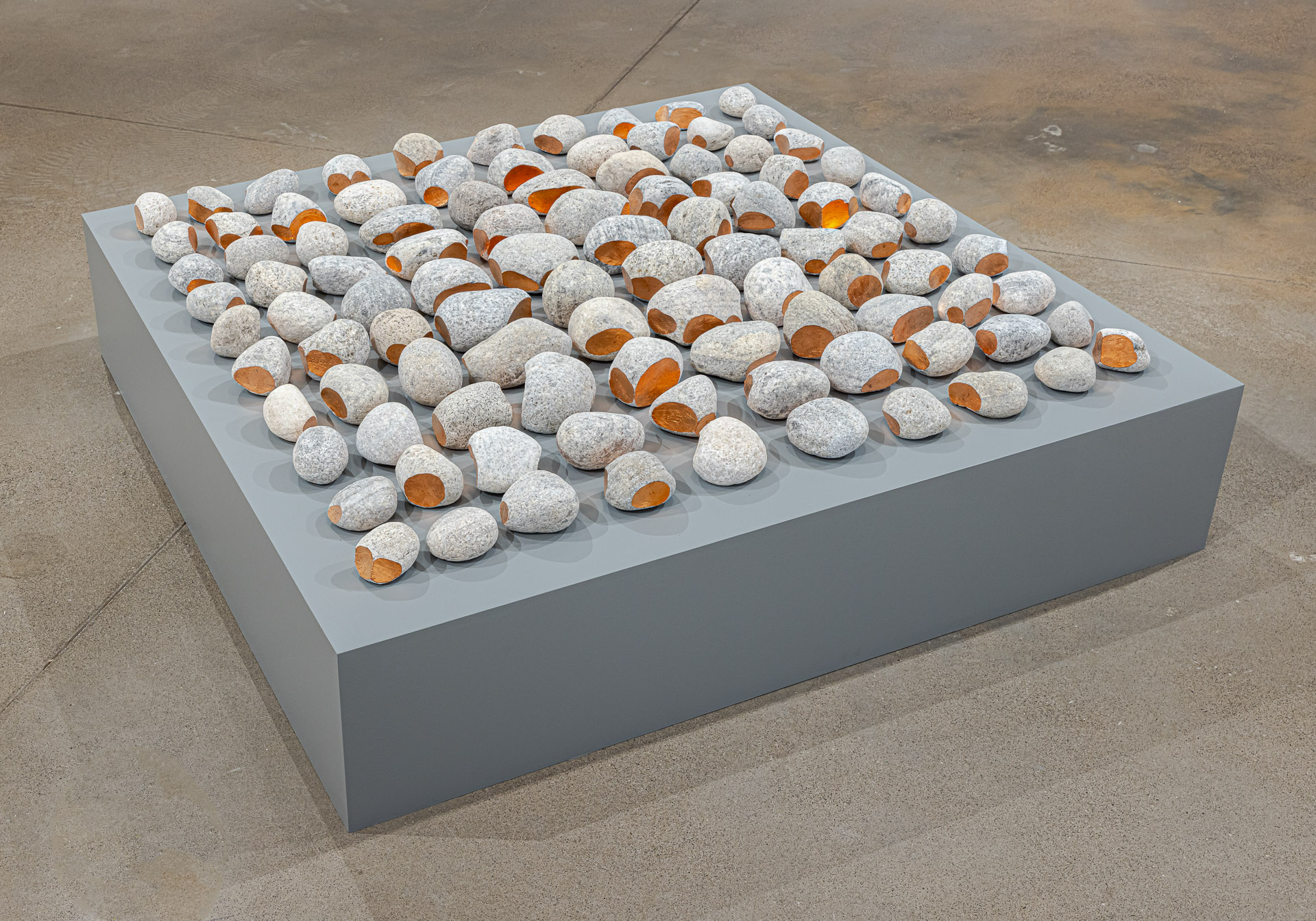
Michael Belmore, Resolve, 2022–ongoing. Stone and copper leaf, variable dimensions. Courtesy the artist.
Michael Belmore (1971– ) is an Anishnaabe artist with a BFA and MFA from OCAD University and the University of Ottawa, respectively. Belmore has exhibited at spaces including the Ojibway Cultural Foundation, Royal Melbourne Institute of Technologies Project Space Gallery, and Maison des Arts de Laval. The National Gallery of Canada, the Art Gallery of Ontario, and the National Museum, the Mackenze Art Gallery, and the National Museum of the American Indian are among the institutions that have collected Belmore’s work.
Bob Boyer (1948–2004) was a Métis painter, installation artist, pow wow dancer, curator, and educator affiliated with the First Nations University. He graduated from the University of Saskatchewan with a Bachelor of Education, specializing in arts education. Boyer has exhibited his work at institutions including the MacKenzie Art Gallery, Edmonton Art Gallery, and Canadian Museum of History. Boyer’s is featured in the collections of of the National Gallery of Canada, the Winnipeg Art Gallery, and the Canadian Broadcasting Corporation.
Jack Bush (1909–1977) was a prolific painter who was known for his explorations with abstraction. He studied at the Royal Canadian Academy and the Ontario College of Art (now OCAD University) and co-founded the Painters Eleven. Bush co-represented Canada at the 1967 São Paulo Biennale, and his work is held in numerous public and private collections. Major retrospectives were presented at the Art Gallery of Ontario and the National Gallery of Canada.
Artist and educator Edward Poitras (1953– ) is a member of the Gordon First Nation and is known for his mixed-media sculptures and installations. Poitras studied at the Saskatchewan Indigenous Cultural Centre and at Manitou College. Poitras’ work is held in numerous public collections including the Remai Modern, the Mackenze Art Gallery, and the National Gallery of Canada. Poitras represented Canada at the 1995 Venice Biennale and received the Governor General’s Award in Visual and Media Arts in 2002.
Artist Tariku Shiferaw (1983– ) primarily works in painting and installation. Shiferaw received his MFA from Parsons School of Design as well as participated in the Whitney’s Independent Study Program in 2019. Shiferaw has exhibited in numerous solo and group exhibitions including at the Los Angeles County Museum of Art, Southampton African American Museum, and the Coma Gallery, Sydney, Australia. Shiferaw also participated in an artist-in-residence at the World Trade Center through Silver Art Projects and at ARCAthens in Greece.
Installation team for exhibitions: Uroš Jelić (lead), Corinne Carlson, Jonah Kamphorst, Matthew Koudys, Joseph Thomson, Manny Trinh, Morgan Zigler
Curated by Lillian O’Brien Davis with Michael Belmore.
See also:

